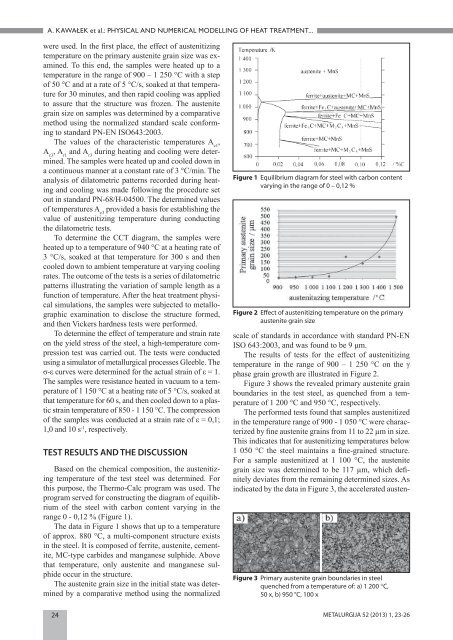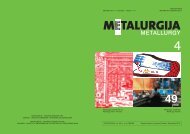Metalurgija: sadašnjost Metallurgy: Present Metalurgija ... - CARNet
Metalurgija: sadašnjost Metallurgy: Present Metalurgija ... - CARNet
Metalurgija: sadašnjost Metallurgy: Present Metalurgija ... - CARNet
You also want an ePaper? Increase the reach of your titles
YUMPU automatically turns print PDFs into web optimized ePapers that Google loves.
A. KAWAŁEK et al.: PHYSICAL AND NUMERICAL MODELLING OF HEAT TREATMENT...<br />
were used. In the fi rst place, the effect of austenitizing<br />
temperature on the primary austenite grain size was examined.<br />
To this end, the samples were heated up to a<br />
temperature in the range of 900 – 1 250 °C with a step<br />
of 50 °C and at a rate of 5 °C/s, soaked at that temperature<br />
for 30 minutes, and then rapid cooling was applied<br />
to assure that the structure was frozen. The austenite<br />
grain size on samples was determined by a comparative<br />
method using the normalized standard scale conforming<br />
to standard PN-EN ISO643:2003.<br />
The values of the characteristic temperatures A c1 ,<br />
A c3 , A r1 and A r3 during heating and cooling were determined.<br />
The samples were heated up and cooled down in<br />
a continuous manner at a constant rate of 3 °C/min. The<br />
analysis of dilatometric patterns recorded during heating<br />
and cooling was made following the procedure set<br />
out in standard PN-68/H-04500. The determined values<br />
of temperatures A c3 provided a basis for establishing the<br />
value of austenitizing temperature during conducting<br />
the dilatometric tests.<br />
To determine the CCT diagram, the samples were<br />
heated up to a temperature of 940 °C at a heating rate of<br />
3 °C/s, soaked at that temperature for 300 s and then<br />
cooled down to ambient temperature at varying cooling<br />
rates. The outcome of the tests is a series of dilatometric<br />
patterns illustrating the variation of sample length as a<br />
function of temperature. After the heat treatment physical<br />
simulations, the samples were subjected to metallographic<br />
examination to disclose the structure formed,<br />
and then Vickers hardness tests were performed.<br />
To determine the effect of temperature and strain rate<br />
on the yield stress of the steel, a high-temperature compression<br />
test was carried out. The tests were conducted<br />
using a simulator of metallurgical processes Gleeble. The<br />
σ-ε curves were determined for the actual strain of ε = 1.<br />
The samples were resistance heated in vacuum to a temperature<br />
of 1 150 °C at a heating rate of 5 °C/s, soaked at<br />
that temperature for 60 s, and then cooled down to a plastic<br />
strain temperature of 850 - 1 150 °C. The compression<br />
of the samples was conducted at a strain rate of ε = 0,1;<br />
1,0 and 10 s -1 , respectively.<br />
TEST RESULTS AND THE DISCUSSION<br />
Based on the chemical composition, the austenitizing<br />
temperature of the test steel was determined. For<br />
this purpose, the Thermo-Calc program was used. The<br />
program served for constructing the diagram of equilibrium<br />
of the steel with carbon content varying in the<br />
range 0 - 0,12 % (Figure 1).<br />
The data in Figure 1 shows that up to a temperature<br />
of approx. 880 °C, a multi-component structure exists<br />
in the steel. It is composed of ferrite, austenite, cementite,<br />
MC-type carbides and manganese sulphide. Above<br />
that temperature, only austenite and manganese sulphide<br />
occur in the structure.<br />
The austenite grain size in the initial state was determined<br />
by a comparative method using the normalized<br />
Figure 1 Equilibrium diagram for steel with carbon content<br />
varying in the range of 0 – 0,12 %<br />
Figure 2 Eff ect of austenitizing temperature on the primary<br />
austenite grain size<br />
scale of standards in accordance with standard PN-EN<br />
ISO 643:2003, and was found to be 9 μm.<br />
The results of tests for the effect of austenitizing<br />
temperature in the range of 900 – 1 250 °C on the γ<br />
phase grain growth are illustrated in Figure 2.<br />
Figure 3 shows the revealed primary austenite grain<br />
boundaries in the test steel, as quenched from a temperature<br />
of 1 200 °C and 950 °C, respectively.<br />
The performed tests found that samples austenitized<br />
in the temperature range of 900 - 1 050 °C were characterized<br />
by fi ne austenite grains from 11 to 22 µm in size.<br />
This indicates that for austenitizing temperatures below<br />
1 050 °C the steel maintains a fi ne-grained structure.<br />
For a sample austenitized at 1 100 °C, the austenite<br />
grain size was determined to be 117 µm, which defi -<br />
nitely deviates from the remaining determined sizes. As<br />
indicated by the data in Figure 3, the accelerated austen-<br />
Figure 3 Primary austenite grain boundaries in steel<br />
quenched from a temperature of: a) 1 200 °C,<br />
50 x, b) 950 °C, 100 x<br />
24 METALURGIJA 52 (2013) 1, 23-26
















